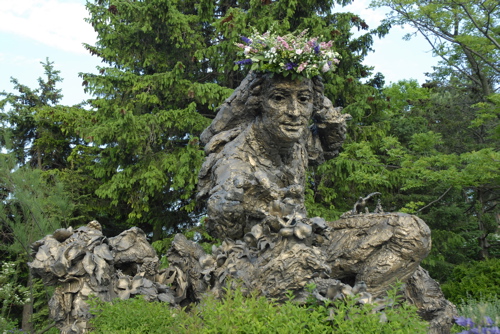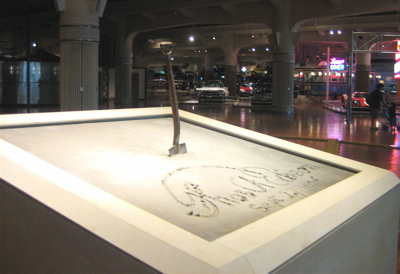
Why isn't anybody putting up statues or stained-glass windows to honor modern heroes of the natural world?
Given the acrimonious state of the current turf wars, I guess I shouldn't be surprised. It's hard to expect celebratory monuments while terms like granola crunching crackpots and frankenfood still dominate the conversation. And yet we all live on a poorer, grayer planet if we don't have people who are admired, respected, and honored for enlarging our understanding of the world of plants.
Luther Burbank window image courtesy Grace Cathedral, San Francisco
Where can we find models for the next generation of botanical heroes and heroines? Examples abound, but I'll limit myself to three very different figures -- each widely honored in his day, but all somewhat neglected of late.
Consider Carl Linnaeus, the 18th century Swedish botanist who created the modern binomial system of naming plants. Linnaeus, revered by Goethe and Rousseau, considered a founder of modern science of ecology, is honored by statues around the world, including this one in the Chicago Botanic Garden.
Chicago Botanic Garden photo by Robin Carlson
Outside of his home town of Uppsala, however, Linnaeus is hardly a household name today.
Then there was Alexander von Humboldt, the Prussian naturalist and explorer who roamed the wilds of Latin America for several years, starting in 1799, and then spent another two decades writing up his findings. Humboldt was wildly popular in the United States, although he visited only once, in 1804. After his death in 1869 there were dozens of parks, schools, squares, boulevards, cities, and counties named after him, as well as mountains, rivers, plants, animals (including a penguin and giant squid the Mexicans call the red devil) and, most famously, an ocean current.
The briefest glance at an atlas or index of city streets will find Humboldt's name is still in common use, although few people who live in or near any of these places know who he was.
What remains, beside all those mountains and streams and large aquatic animals, is a number of statues. Here's one of them, perched above the entry to one of the oldest buildings on the Stanford University campus in Palo Alto, California.
Massachusetts-born plant breeder Luther Burbank, who died in California in 1926, was another man of many honors. All sorts of fruits, flowers, and produce were named after Burbank, along with parks, schools, highways, and even a sanitary district. He was glorified in stained glass windows like the one shown above, which towers 16' high in San Francisco's Grace Cathedral, and the one in Detroit's All Saint's Episcopal Church.
Burbank was also immortalized in Diego Rivera's 1931 mural, the Allegory of California, where Burbank kneels beneath the fruit filled hand of a goddess of plenty, nurturing an unidentifiable plant while other industries extract all they can from the natural landscape. That same year, Frida Kahlo painted a Portrait of Luther Burbank that is, like much of her work, both heroic and more than a little scary.
The strangest and perhaps the most enduring memorial to Burbank, though, is not a statue or a painting. It is a shovel. More specifically, it is Burbank's shovel, proudly standing upright in the cement dedication stone of The Henry Ford museum in Dearborn, Michigan.
Thomas Edison planted Burbank's garden shovel in Ford's museum, thrusting it into the new cement at a 1928 groundbreaking ceremony witnessed by an international crowd of celebrities and dignitaries. As the accompanying sign reports, "Edison's act set in motion Henry Ford's vision to honor the common genius of the American people."
Burbank's shovel still presides over the main entrance to Ford's museum, although few visitors today stop to notice as they rush past to the IMAX theater or the Weinermobile. Like a botanical Excalibur, it stands there waiting for a new garden hero strong enough to wrest it back into power.
Any nominees?



